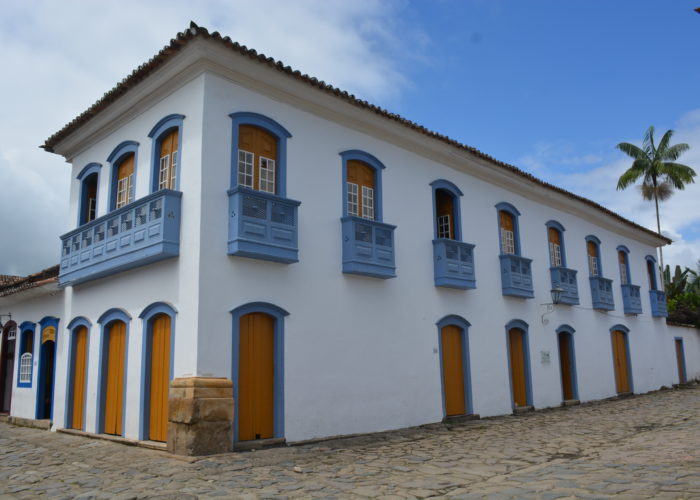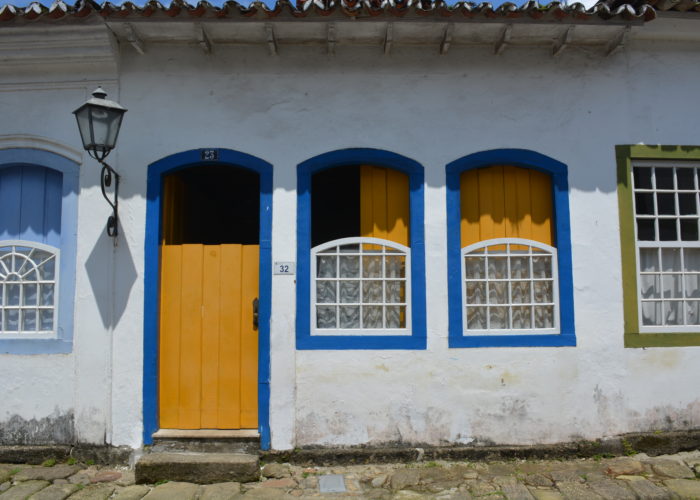Located around 200 kilometres south of Rio de Janeiro, the port town of Paraty is one of Brazil’s most picturesque and historically significant coastal towns. Founded in 1597 and officially established in 1667, it played a significant role in Brazil’s colonial history, serving as a key port for shipping gold and other minerals from the mines of Minas Gerais. Its strategic location, protected by a network of headlands, islands, and hidden bays, made it a relatively safe harbour from pirates and other threats.
Today, Paraty remains one of the most well-preserved colonial towns in Brazil, offering visitors a glimpse into its rich history while also serving as a hub for eco-tourism.
Paraty is part of the state of Rio de Janeiro and sits at the heart of the Costa Verde (Green Coast). The town’s population is around 43,000 inhabitants, a number that expands significantly during peak tourist seasons due to its proximity to Rio de Janeiro and São Paulo. The surrounding area is notable for its lush semi-tropical forests, clear waters, and secluded beaches.
During our stay we stayed at Pousada de Tesouro, a beautiful pousada in in old colonial building with upper floor elegant balconies and a pool close to the main sites of the historical entre.

Geography & Climate
Paraty is situated in a large bay surrounded by numerous islands, headlands, and inlets. The town’s location gave it a strategic advantage during the colonial period, as its many natural harbours provided protection from pirates. The coastline is particularly stunning, with semi-tropical Atlantic forests (Mata Atlântica) descending right to the water’s edge, creating a unique landscape of mountains, beaches, and crystal-clear waters.
The climate in Paraty is humid tropical, with warm temperatures year-round and heavy rainfall during the summer months. The lush greenery surrounding the town is nourished by this climate, making it an ideal spot for nature lovers.

History & Economy
Paraty’s early development was tightly linked to the gold mines of Minas Gerais. From the late 17th century, it served as the final point of the Caminho do Ouro (Gold Trail), a rugged path over the mountains used to transport gold from Ouro Preto. However, when gold reserves dwindled, Paraty’s importance diminished, leaving it largely in isolation. This decline actually helped preserve its colonial architecture, making the town one of Brazil’s most well-preserved historical sites today. In the earl 20th century, the town was rediscovered and is now an important tourist destination.
Today, Paraty’s economy is heavily reliant on tourism. The town has been carefully preserved, and its historic centre is a UNESCO-listed site. Many of the town’s old colonial buildings have been converted into pousadas, restaurants, and shops, catering to a growing number of visitors, many of whom come from Brazil, South America, and Europe.
Principal Sites
Historic Centre (Centro Histórico)
The historic centre of Paraty is a pedestrian-friendly area where visitors can wander through cobbled streets and admire the town’s colonial architecture. The buildings are mostly painted white with colourful doors and windows, giving the town a distinctive and uniform appearance. The unique feature of Paraty is that during high tide, parts of the town centre are deliberately flooded by the sea, a centuries-old design that helps to clean the streets naturally.

Igreja de Santa Rita
One of the town’s main churches, Igreja de Santa Rita, was built in 1722 and is the oldest church in Paraty. Its simple yet elegant façade reflects the town’s modest wealth in comparison to Minas Gerais. Despite its modesty, the church houses a museum of sacred art, which provides insight into the town’s religious and cultural history.
Igreja de Nossa Senhora dos Remédios (Church of Our Lady of Remedies)
The main church of Paraty, Nossa Senhora dos Remédios, began construction in 1787 and was completed in 1873. This church, like many in Paraty, was funded by the community, and although its decoration is more modest than those in places like Ouro Preto, it serves as a key religious and cultural site for the town.
The Gold Trail (Caminho do Ouro)
This historical path, used for transporting gold from Minas Gerais to Paraty, remains partially accessible today. Visitors can explore sections of the trail through the rainforest, a journey that showcases both the rugged nature of the original route and the stunning surrounding landscapes.

Fortress of Defender of Paraty (Forte Defensor Perpétuo)
This 18th-century fortress sits on a hill overlooking the bay and once served to protect the town from invaders. Today, it offers panoramic views of the coastline and houses a small museum.
Boat Trips Around the Bay
One of the most popular activities in Paraty is to take a boat trip around the bay, exploring the hidden beaches and islands that dot the coastline. Many of these trips have a fun, pirate-themed atmosphere, with local musicians providing entertainment. The boat tours typically include stops at secluded beaches where visitors can swim and enjoy lunch, making it a great way to appreciate the natural beauty of the region.

Environment
Paraty is surrounded by the Mata Atlântica, a biodiversity-rich tropical forest that is home to an array of wildlife and plant species. The region is part of a UNESCO-designated Biosphere Reserve, and efforts have been made to preserve the fragile ecosystems of the coastline. The combination of forests, mountains, and pristine beaches make Paraty one of Brazil’s most naturally beautiful areas.
One environmental challenge faced by Paraty is the preservation of its colonial architecture in the face of rising tourism and environmental factors like flooding. The town’s unique tidal streets may provide natural cleaning, but they also present difficulties in maintaining the historic structures that make Paraty so unique.

Final Thoughts
Paraty’s charm lies in its blend of natural beauty and colonial history. With its whitewashed buildings, lush surroundings, and rich cultural heritage, it offers visitors a glimpse into Brazil’s past while allowing them to enjoy its pristine beaches and vibrant local culture. Though not as opulent as the mining towns of Minas Gerais, Paraty’s simplicity and connection to the sea make it a truly special destination.
Date: 26/11/2018 to 29/11/2018














